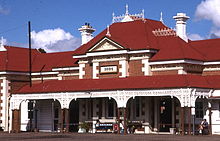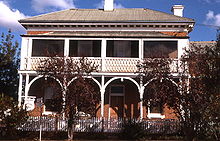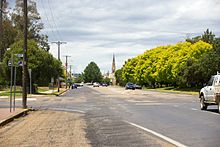- Mudgee
-
Mudgee
New South WalesPopulation: 8,249 (2006 Census)[1] Postcode: 2850 Elevation: 454 m (1,490 ft) Location: - 270 km (168 mi) NW of Sydney
- 128 km (80 mi) ESE of Dubbo
- 192 km (119 mi) N of Orange
- 201 km (125 mi) W of Muswellbrook
LGA: Mid-Western Regional Council County: Wellington State District: Orange Federal Division: Parkes Mean max temp Mean min temp Annual rainfall 23.0 °C
73 °F8.3 °C
47 °F673.9 mm
26.5 inMudgee (
 /ˈmʌdʒi/) is a town in the central west of New South Wales, Australia. It is located in the broad fertile Cudgegong River valley 261 kilometres north west of Sydney. Mudgee is the centre of the Mid-Western Regional Council Local Government Area. At the 2006 census, Mudgee had a population of 8,249 people.[1]
/ˈmʌdʒi/) is a town in the central west of New South Wales, Australia. It is located in the broad fertile Cudgegong River valley 261 kilometres north west of Sydney. Mudgee is the centre of the Mid-Western Regional Council Local Government Area. At the 2006 census, Mudgee had a population of 8,249 people.[1]The Mudgee district lies across the edge of the geological structure known as the Sydney Basin.[2]
Contents
Economy
The Mudgee district is well-known for its fine wine. Mudgee has developed as a wine producing region and is a popular destination for tourists, who visit the forty wineries operating in the Mudgee district. Other rural produce includes cattle, sheep, wheat, lucerne, olives, fruit, tomatoes, corn, honey and dairy products.
The Ulan coal mines are in the district. During the 19th century, the area was a major goldmining area and the district also produces marble, pottery clays, shale and dolomite. The tourism industry is also a growing industry based largely on the wineries. A laboratory was established in 1987 to test meat for pesticide residues.[citation needed]
Mudgee has a hospitality sector with many bed & breakfasts, cafes and restaurants which add flair to its diverse wine community.
History
Early history to 1850
The name Mudgee is derived from the Wiradjuri term Moothi meaning "Nest in the Hills"[3] or "mou-gee" meaning "contented".[4] James Blackman was the first European settler to cross the Cudgegong River in 1821 followed quickly by Lieutenant William Lawson who was then commandant of Bathurst. Lawson would later take up 6,000 acres (24 km²) in the area.
George and Henry Cox, sons of William Cox, were the first settlers on the Cudgegong River when they established the Menah run, 3 kilometres north of the current town. The European settlers were soon in conflict with the Wiradjuri over a range of issues including killing of livestock and animals such as kangaroos and possums which were major food sources for the Wiradjuri. Martial law was declared in 1824 leading to a significant reduction in the population of the Wiradjuri.[citation needed]
While the site of Mudgee was surveyed for a village in 1823, Menah was the original settlement having a police station and a lock up by 1833. Robert Hoddle designed the village which was gazetted in 1838. John Blackman built a slab hut, the first dwelling in Mudgee and its general store. By 1841, there were 36 dwellings, three hotels, a hospital, a post office, two stores and an Anglican church. The police station moved from Menah in the mid-1840s while an Anglican school was established in that decade as well.
History 1850 to present
In 1851, the population of Mudgee was 200. However, the population exploded as the discovery of gold in nearby Hargraves by Edward Hargraves led to a gold rush in New South Wales. While no gold was found in Mudgee itself, the town prospered as gold was discovered in nearby towns such as Gulgong, Hill End and Windeyer, New South Wales temporarily reached populations of 20,000. Mudgee was a centre for the local goldfields and grew rapidly as a result.[citation needed]
Mudgee was declared as a municipality in 1860 making it the second oldest municipality west of the Great Dividing Range with a population of 1500 in 1861. A public school was built in the 1850s together with the present Catholic and Anglican churches and a Methodist and Presbyterian church. A new police station, courthouse, Mechanics' Institute and a town hall were built in the 1860s. There were four coach factories operating in Mudgee to cater for the demand of the nearby goldfields. The National Trust of Australia has a number of these buildings registered including the Mudgee Museum (formerly the Colonial Inn),[5] the Catholic presbytery, the court house, the police station and the Anglican Church. On 1 June 1861 the Electric Telegraph system arrived and was opened for messages to be transmitted and received at the Telegraph office.[6]
One of the gold miners attracted to the Mudgee district was Niels Peter Larsen who married Louisa Albury in Mudgee in 1866. They had a child, leading Australian poet Henry Lawson in Grenfell in 1867 and changed their names to Peter and Louisa Lawson. By the birth of their third child, they moved to a selection at Pipeclay (now Eurunderee) 8 km north of Mudgee. Louisa Lawson's vigorous lobbying led to the establishment of the slab-and-bark Eurunderee Public School in 1876 with Henry Lawson attending the school for the first time aged nine. He would later write about the school in his poem "The Old Bark School". Lawson would later attend St. Matthews Central School, Mudgee before his progressively worsening deafness leading to him leaving school at the age of 14. Lawson would live in the Mudgee district until the age of 15 and many of his stories were written about the district.
As the gold mines petered out in the latter half of the 19th century, Mudgee was sustained by the strength of its wool industry as well as the nascent wine industry established by a German immigrant, Adam Roth, in the 1850s. The opening of the railway extension from Rylstone to Mudgee occured on 10 September 1884.[7][8] The railway boosted the town's agricultural industries. The railway between Rylstone and Mudgee closed on 2 March 1992.[8] This same railway section re-opened eight years later, on 2 September 2000.[8] The Wallaby Track Drive Tour visits various sites associated with Lawson including the old Eurundee Public School, the Henry Lawson memorial, the Budgee Budgee Inn, Sapling Gully, Golden Gully and the Albury Pub which was owned by Lawson's grandfather.
Heritage buildings
The following buildings are listed on the Register of the National Estate.[9]
- Havilah Property, 1870, and Chapel, 1905
- Burrundulla, circa 1865
- Railway Station, designed by John Whitton, 1884
- St Mary's Catholic Church, attributed to Edward Gell, 1857
- Post Office, designed by Colonial Architect Alexander Dawson, 1860
- Police Station and Stables, circa 1860
- Court House, 1861
- Public School
Climate
Mudgee average temperatures range between 15 and 40 degrees Celsius in the summer (December - February) and -3 and 15 degrees Celsius in the winter (June–August). The average annual rainfall is 674.4 millimetres (26.55 in).[10]
Climate data for Mudgee Month Jan Feb Mar Apr May Jun Jul Aug Sep Oct Nov Dec Year Average high °C (°F) 31.0
(87.8)30.2
(86.4)27.8
(82.0)23.3
(73.9)18.8
(65.8)15.2
(59.4)14.4
(57.9)16.0
(60.8)19.6
(67.3)23.4
(74.1)26.9
(80.4)29.8
(85.6)23.0 Average low °C (°F) 15.5
(59.9)15.4
(59.7)13.0
(55.4)8.5
(47.3)5.0
(41.0)2.6
(36.7)1.3
(34.3)2.3
(36.1)4.4
(39.9)7.6
(45.7)10.8
(51.4)13.7
(56.7)8.3 Precipitation mm (inches) 68.0
(2.677)64.2
(2.528)50.3
(1.98)44.2
(1.74)49.3
(1.941)55.0
(2.165)53.2
(2.094)53.0
(2.087)51.5
(2.028)60.3
(2.374)61.0
(2.402)64.2
(2.528)674.4
(26.551)Source: [10] Gallery
Notable people from Mudgee
- Aaron Downes - professional football player
- Darrell Hair - international cricket umpire
- Ken Sutcliffe - television Personality, sports reader for Channel Nine
- Natarsha Belling - national newsreader for Channel 10
- Henry Lawson - one of Australia's most recognised poets and short story writers. Lived in Mudgee for 16 years during childhood after his birth in Grenfell
- Jamie Fitzgerald - former professional rugby league player who played 71 First Grade NRL games
- Louisa Lawson - mother of Henry Lawson, Prolific feminist activist.
- Lisa Keightley - cricketer, first woman to score a century at Lord's in England
- Scott McGregor - Australian actor, TV presenter and railway historian
- David Lowe - Winemaker and owner Lowe Wines, President NSW Wine Industry Association, Vice President Australian Winemakers Federation
See also
References
- ^ a b Australian Bureau of Statistics (25 October 2007). "Mudgee (Urban Centre/Locality)". 2006 Census QuickStats. http://www.censusdata.abs.gov.au/ABSNavigation/prenav/LocationSearch?collection=Census&period=2006&areacode=UCL156000&producttype=QuickStats&breadcrumb=PL&action=401. Retrieved 2 November 2009.
- ^ http://www.dpi.nsw.gov.au/__data/assets/image/0007/96847/20758.gif
- ^ "Mudgee". Geographical Names Board of New South Wales. http://www.gnb.nsw.gov.au/name_search/extract?id=ujjLvqZTMn. Retrieved 2 November 2009.
- ^ "PLACE NAMES.". The Australian Women's Weekly (1932-1982) (1932-1982: National Library of Australia): p. 61. 13 May 1964. http://nla.gov.au/nla.news-article55185386. Retrieved 22 February 2011.
- ^ "Colonial Inn Museum". Mudgee Historical Society Inc. http://www.mudgeemuseum.com/. Retrieved 15 November 2011.
- ^ Annette Piper (1/6/1861). "Western Post June 1861". Western Post. http://archiver.rootsweb.ancestry.com/th/read/AUS-NSW/2002-09/1032849563. Retrieved 14 March 2011.
- ^ "THE EXTENSION OF THE RAILWAY TO MUDGEE.". The Sydney Morning Herald (NSW : 1842 - 1954) (NSW: National Library of Australia): p. 5. 9 September 1884. http://nla.gov.au/nla.news-article28368162. Retrieved 15 November 2011.
- ^ a b c Bozier, Rolfe. "Gwabegar Line". NSWrail.net. http://www.nswrail.net/lines/show.php?name=NSW:gwabegar. Retrieved 15 November 2011.
- ^ The Heritage of Australia, Macmillan Company, 1981, p.2/287
- ^ a b "Summary statistics Mudgee (George Street)". Bureau of Meteorology. http://www.bom.gov.au/climate/averages/tables/cw_062021.shtml.
External links
 Media related to Mudgee at Wikimedia CommonsCategories:
Media related to Mudgee at Wikimedia CommonsCategories:- Towns in New South Wales
- Wine regions of New South Wales
- Australian Aboriginal placenames
- Towns in the Central West, New South Wales
Wikimedia Foundation. 2010.









